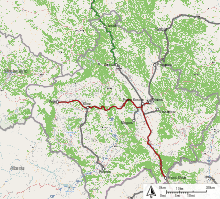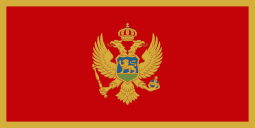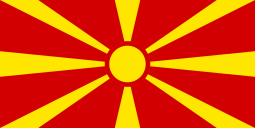Kosovo Railways
| Private | |
| Industry | Rail Transport |
| Headquarters | Pristina, Kosovo[a] |
| Website | http://www.trainkos.com |

Trainkos sh.a also (Albanian: Operimet me Trena të Hekurudhave të Kosovës sh.a) is the railway carrier of Kosovo[a]. It was originally formed as the Kosovo Railways J.S.C UNMIK Railways[1] from the lines of the former Yugoslav Railways that lie on Kosovan territory. In 2011, the company was split into two public companies called Trainkos and Infrakos, the latter responsible for rail maintenance.
History
The first railway line was built under Turkish guidance for the Compagnie des Chemins de Fer Orientaux (CO), led by Maurice de Hirsch. It started in Thessaloniki, went on north to Skopje and reached Kosovska Mitrovica in 1873.
Before the First World War it was used by the Serbian Railways which operated as Yugoslav Railways between 1918 and 1992, and stopped their operations in Kosovo after the NATO intervention in 1999. In 2008 Serbian Railways restored some of its routes in Northern Kosovo region.
Rail network

Trainkos operates 430 km (267 mi) of railway in Kosovo, of which 333 km (207 mi) serve both freight and passenger and 97 km (60 mi) only serve freight traffic. The non-electrified network originally consisted of two lines crossing at Fushë Kosovë railway station in Kosovo Polje: A main line going from Kraljevo in western Serbia via Kosovska Mitrovica and Kosovo Polje to Skopje in Macedonia, and a branch line in east-west direction from Niš in southern Serbia via Pristina railway station in the capital Pristina and Kosovo Polje with one branch leading to Peć and the other one to Prizren. Of these lines, the one from Pristina to Peć and the one from Kosovo Polje to Macedonia are still served by passenger trains. Some more parts of the network are occasionally served by freight trains, like Kosovo Polje - Obilić; the other parts of the network are currently unused. For years, there have been plans to extend the branch to Prizren across the border to Albania, to create a link to the network of the Hekurudha Shqiptare. However, these projects are no more than letters of intent.
Rail links with adjacent countries
 Albania - No Connection
Albania - No Connection Montenegro - No Connection
Montenegro - No Connection Macedonia - open
Macedonia - open Serbia - closed in Zvečan/ Lešak and closed in Merdare
Serbia - closed in Zvečan/ Lešak and closed in Merdare
Operations
Passenger traffic
Trainkos operates three services: Local train, Freedom of Movement and InterCity. Usually, the trains consist of either two former SJ Y1 DMUs or a former NSB Di 3 with former SJ coaches. The InterCity trains usually consist of a Di 3 locomotive, one former SJ coach of Trainkos and one Macedonian coach.
Between Pristina and Peć there are two daily local train pairs, with the train staying in Peć overnight. One trip takes close to two hours.
Between Kosovo Polje and Elez Han (border to Macedonia), there are two Freedom of Movement train pairs and one local train pair. As the only international train connection there is also the InterCity train pair (IC 891/892) from Pristina via Kosovo Polje to Skopje and back. In direction of Kosovo Polje, all trains stop at all stations; in the other direction the trains skip various stations, only the local train in the evening stops everywhere. The trains need close to one and a half hours for the trip from Kosovo Polje to Elez Han.
Until March 2008 there were two more Freedom of Movement train pairs from Kosovo Polje to Leshak, but this traffic had to be discontinued until further notice due to ongoing tensions with Serbia.
Freight traffic
National freight traffic is of importance, as it serves various industries such as calcium carbonate plants throughout the country. International freight traffic is handled via Elez Han, and the container terminal is close to Pristina airport, near the Miradi station.
Incomplete list of regular freight services:
- Coal from Obilić (Kastriot) to the NewCoFerronikeli plant near Glogovac. The coal cars are pulled to Obilić station by a steam locomotive operated by the coal mine. Usually runs every second day.
- Ore trains from the Golesh mine (south-west of Pristina airport) to the NewCoFerronikeli plant. Usually daily.
- Several types of freight (containers, cisterns, bulk goods) between Elez Han (from/to Macedonia) and Miradi, serving several private sidings en route. Usually daily.
Northern Kosovo
On 3 March 2008 (three weeks after the declaration of independence of Kosovo), the Serbian railways ŽS (successor of Yugoslav Railways) announced that they would seize control over the railway infrastructure lying in the northern part of Kosovo, including all personnel, and would resume traffic after having assured compliance to Serbian safety standards.
As of 2009, ŽS runs trains between Kraljevo and North Kosovska Mitrovica. There is both freight and passenger traffic, but without border control, since Serbia considers Kosovo to be part of its own territory. This leads to the situation that, for instance, fuel is transported into Kosovo territory, without toll being paid to the Kosovarian state.[2] The political situation prevents any train traffic between Zvečan and Mitrovica (the line would be in operating condition). From Kosovska Mitrovica, the line is, in principle, served by Trainkos, but there is no regular freight or passenger traffic until Obilić (freight) respectively Kosovo Polje (passengers).
As of January 13, 2017 ŽS extended North Kosovska Mitrovica - Kraljevo line to run as an express train directly to Belgrade. This line now connects North Kosovska Mitrovica with Belgrade via Raška, Kraljevo, Kragujevac, Lapovo and Mladenovac. This is first time since Kosovo war that direct express train service was established between Belgrade and Kosovo.
Rolling stock
The rolling stock partly stems from the former Yugoslav Railways, and was partly imported from various European countries, such as via the Kosovo Train for Life charter train that arrived in Pristina on 7 September 1999 bringing aid and rolling stock from the United Kingdom and Germany in connection with the Kosovo Force peace-keeping efforts.[3]
Locomotives
Five types of locomotives are in use. There are former Yugoslav diesel-electric class 661 locomotives built by General Motors, former NSB Di 3 locomotives ("NOHABs") imported from Norway (also a construction by General Motors, but built in Sweden by the NoHAB works), a single Vossloh G1700-2 BB a single General Motors JT38CW-DC built mainly from new parts using parts from 661-203 (Bogies) and 661-261 (Compressor and some ancillarys) and a single Electro-Motive Division GT22HW-2, a custom-designed EMD A1A-A1A diesel-electric locomotive built by Đuro Đaković for Yugoslavia. While all types of locomotives are used for freight trains, only the NoHABs and GT22HW-2 are used to pull passenger trains, usually all trains between Kosovo Polje and Peć, and rarely trains between Kosovo Polje and Elez Han.
| Number | Type | Status |
|---|---|---|
| 001 | Former HŽ 2044-031 | Operational passenger traffic |
| 002 | Former JŽ 661 132 | Non Operational |
| 003 | Former JŽ 661 228 | Operational, freight traffic |
| 004 | Former JŽ 661 231 | Non Operational |
| 005 | Former NSB Di3a 619 | Operational, passenger and freight traffic |
| 006 | Former NSB Di3a 633 | Broken electrical generator, in repair (July 2009) |
| 007 | Former NSB Di3b 641 | Operational, passenger and freight traffic |
| 008 | Former NSB Di3b 643 (VR KDs1 2402) | Non Operational, Brake fault |
| 009 | Vossloh G 1700-2 BB | Operational, freight traffic |
| 010 | JT38CW-DC Gredelj-Croatia | Operational, freight traffic |
| Former HŽ 2061-501 |
Diesel railcars
Normally, all trains between Kosovo Polje and Peć are run with former SJ class Y1 diesel railcars built by Fiat. Sometimes, the Y1 are also used on the line to Elez Han. There are also some former FS class ALn 668 railcars available, but these are not needed any more since the delivery of the Y1 and are currently parked at Kosovo Polje.
| Class | Image | Type | Top speed | Number | Built | Builder | Notes | |
|---|---|---|---|---|---|---|---|---|
| mph | km/h | |||||||
| 5800 |  |
Y1 | 81 | 130 | 4 | 1979-1981 | Fiat, Kalmar Verkstad | Former SJ 1281, 1304, 1306, 1313). Were sold in 2007 to Kosovo[4] for local trains between Pristina and Peć. The railcars were renumbered 01, 02, 03, 04 (but still carry their old numbers below the new numbers) and have a red and yellow livery. |
| FS ALn 668 |  |
ALn 668 | 67 | 110 | 3 | 1966 | Fiat | Former Italian Railways 1528, 1531, 1534. In principle operational, small defects, currently not needed |
Carriages
Both carriages from the former Yugoslav Railways as well as second-hand carriages from all over Europe are available, however many of them not in operating condition. At the moment, all locomotive hauled passenger trains use former SJ coaches and, in the case of the InterCity, one carriage of Makedonski Železnici.
| Description | Image | Type | Number | Built | Builder | Notes |
|---|---|---|---|---|---|---|
| ex DB n-Wagen | Silberling | 10 | Former DB, refurbished by Šinvoz in 2017. UIC-numbering:
AB 50 80 31-35 114-3
| |||
| Schlierenwagen | |
Bpz | 7 | 1977-1980 | SGP, JW | Former ÖBB. Acquired in 2009/2011. UIC-numbering:
50 81 29-35 411-6, 507-1, 535-2, 548-5, 675-6, 714-3, 749-9 |
| Schlierenwagen |  |
BDpz | 3 | 1978 | JW | Former ÖBB. Acquired in 2009/2011. UIC-numbering:
50 81 82-35 421-9, 426-8, 428-4 |
| B1 | |
B1 | 10 | 1960-1968 | Kalmar Verkstad | Former SJ. 62 seats. Acquired in 2004. (UIC-)numbering:
B1KU 5096 UIC 50 00 20-76 307-3
|
| UIC-Y Bl |  |
B1 | 10 | GOŠA | Former JŽ.
UIC 50 72 20-10 513-8, 520-3, 541-0, 554-1, 555-8, 635-0, 737-3, 743-1
|
Pictures
Locomotives
 001, JŽ 661 128
001, JŽ 661 128 002, JŽ 661 132
002, JŽ 661 132 003, JŽ 661 228
003, JŽ 661 228 004, JŽ 661 231
004, JŽ 661 231 005, NSB Di 3a 619
005, NSB Di 3a 619 006, NSB Di 3a 633
006, NSB Di 3a 633 007, NSB Di 3b 641
007, NSB Di 3b 641 008, NSB Di 3b 643
008, NSB Di 3b 643 009, Vossloh G 1700
009, Vossloh G 1700
Notes and references
Notes:
| a. | ^ Kosovo is the subject of a territorial dispute between the Republic of Kosovo and the Republic of Serbia. The Republic of Kosovo unilaterally declared independence on 17 February 2008, but Serbia continues to claim it as part of its own sovereign territory. The two governments began to normalise relations in 2013, as part of the Brussels Agreement. Kosovo has received formal recognition as an independent state from 111 out of 193 United Nations member states. |
References:
- ↑ Journey by Freedom of Movement Train
- ↑ Travel report "Balkan-Express" (German)
- ↑ "Kosovo aid train gets through". BBC News Online. 27 September 1999. Retrieved 17 October 2014.
- ↑ http://www.accessmylibrary.com/coms2/summary_0286-33617560_ITM
See also
External links
- Trainkos Official Website
- Infrakos Official Website
- Eisenbahn im Kosovo 1874 bis heute (Kosovo Railways Fanpage, German)
| Wikimedia Commons has media related to Kosovo Railways. |